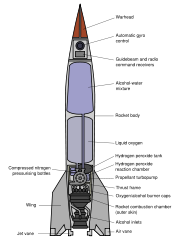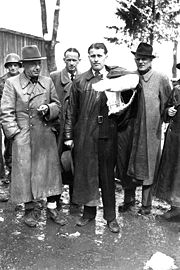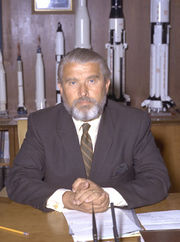Wernher von Braun
2008/9 Schools Wikipedia Selection. Related subjects: Engineers and inventors
| Dr. Wernher von Braun | |
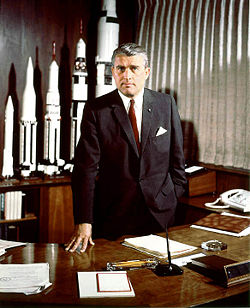 Wernher von Braun stands at his desk in the Marshall Space Flight Centre, Huntsville, Alabama, in May 1964, with models of rockets developed and in progress.
|
|
| Born | March 23, 1912 Wirsitz, German Empire |
|---|---|
| Died | June 16, 1977 (aged 65) Alexandria, Virginia, USA |
| Cause of death | Cancer |
| Occupation | German rocket engineer and designer. |
| Spouse(s) | Maria Luise von Quistorp (1947–1977) |
Dr. Wernher Magnus Maximilian Freiherr ('Baron') von Braun ( March 23, 1912 – June 16, 1977), a German rocket physicist and astronautics engineer, became one of the leading figures in the development of rocket technology in Germany and the United States. Wernher von Braun is sometimes said to be the preeminent rocket scientist of the 20th century.
In his 20s and early 30s, von Braun was the central figure in Germany's pre-war rocket development program, responsible for the design and realization of the deadly V-2 combat rocket during World War II. After the war, he and some of his rocket team were taken to the United States as part of the then-secret Operation Overcast. In 1955, ten years after entering the country, von Braun became a naturalized U.S. citizen.
Von Braun worked on the American intercontinental ballistic missile (ICBM) program before joining NASA, where he served as director of NASA's Marshall Space Flight Centre and the chief architect of the Saturn V launch vehicle, the superbooster that propelled the Apollo spacecraft to the Moon. He is generally regarded by his supporters as the father of the United States space program, both for his technical and organizational skills, and for his public relations efforts on behalf of space flight. He received the 1975 National Medal of Science.
Biography
Early life
Wernher von Braun was born in Wirsitz (Wyrzysk), Province of Posen, German Empire. He was born second of three sons. His father, the conservative civil servant Magnus Freiherr von Braun (1877–1972), although never a party politician, served as a Minister of Agriculture in the Federal Cabinet during the Weimar Republic. His mother, Emmy von Quistorp (1886–1959) could trace ancestry through both her parents to medieval European royalty. Von Braun also had a younger brother, also named Magnus Freiherr von Braun, born in 1919. Upon Wernher von Braun's Lutheran confirmation, his mother gave him a telescope, and he discovered a passion for astronomy and the realm of outer space. When Wyrzysk was ceded to Poland in 1918, his family, like many other German families, moved. They settled in Berlin, where the 12-year-old von Braun, inspired by speed records established by Max Valier and Fritz von Opel, caused a major disruption in a crowded street by firing off a toy wagon to which he had attached a number of fireworks. The youngster was taken into custody by the local police until his father came to collect him.
Starting in 1925 von Braun attended a boarding school at Ettersburg castle near Weimar where at first he did not do well in physics and mathematics. In 1928 his parents moved him to the Hermann-Lietz-Internat (also a residential school) on the East Frisian North Sea island of Spiekeroog, where he acquired a copy of the book Die Rakete zu den Planetenräumen (The Rocket into Interplanetary Space) by rocket pioneer Hermann Oberth. The idea of space travel had always fascinated von Braun, and from that point on he applied himself to physics and mathematics in order to pursue his interest in rocketry.
Starting in 1930, he attended the Technical University of Berlin, where he joined the Verein für Raumschiffahrt (VfR, the "Spaceflight Society") and assisted Hermann Oberth in liquid-fueled rocket motor tests. He also studied at ETH Zurich. Although he worked mainly on military rockets in his later years, space travel remained his primary interest.
German career
The Prussian rocketeer
Von Braun was working on his creative doctorate when the National Socialist German Workers Party took over Germany, and rocketry almost immediately became a national agenda. An artillery captain, Walter Dornberger, arranged an Ordnance Department research grant for him, and von Braun then worked next to Dornberger's existing solid-fuel rocket test site at Kummersdorf. He was awarded a doctorate in physics ( aerospace engineering) on July 27, 1934 from the University of Berlin for a thesis titled About Combustion Tests; his doctoral advisor was Erich Schumann. However, this thesis was only the public part of von Braun's work. His actual full thesis, Construction, Theoretical, and Experimental Solution to the Problem of the Liquid Propellant Rocket (dated April 16, 1934) was kept classified by the army, and was not published until 1960. By the end of 1934, his group had successfully launched two rockets that rose to heights of 2.2 and 3.5 kilometers.
At the time, Germany was highly interested in American physicist Robert H. Goddard's research. Before 1939, German scientists occasionally contacted Goddard directly with technical questions. Wernher von Braun used Goddard's plans from various journals and incorporated them into the building of the Aggregat 4 (A-4) series of rockets. One of the A-4 rockets is the well known V-2. In 1963, von Braun reflected on the history of rocketry, and said of Goddard's work: "His rockets ... may have been rather crude by present-day standards, but they blazed the trail and incorporated many features used in our most modern rockets and space vehicles." Goddard confirmed his work was used by von Braun when, after the war ended, Goddard inspected captured German V-2s, and recognized many components which he had invented.
There were no German rocket societies after the collapse of the VFR, and civilian rocket tests were forbidden by the new Nazi regime. Only military development was allowed and to this end, a larger facility was erected at the village of Peenemünde in northern Germany on the Baltic Sea. This location was chosen partly on the recommendation of von Braun's mother, who recalled her father's duck-hunting expeditions there. Dornberger became the military commander at Peenemünde, with von Braun as technical director. In collaboration with the Luftwaffe, the Peenemünde group developed liquid-fuel rocket engines for aircraft and jet-assisted takeoffs. They also developed the long-range A-4 ballistic missile and the supersonic Wasserfall anti-aircraft missile.
In November 1937 (other sources: December 1, 1932), von Braun joined the National Socialist German Workers Party. An Office of Military Government, United States document dated April 23, 1947 states that von Braun joined the Waffen-SS ( Schutzstaffel) horseback riding school in 1933, then the National Socialist Party on May 1, 1937 and became an officer in the Waffen-SS from May 1940 until the end of the war.
Amongst his comments about his NSDAP membership von Braun has said:
I was officially demanded to join the National Socialist Party. At this time (1937) I was already technical director of the Army Rocket Centre at Peenemünde ... My refusal to join the party would have meant that I would have to abandon the work of my life. Therefore, I decided to join. My membership in the party did not involve any political activities ... in Spring 1940, one SS- Standartenführer (SS Colonel) Müller ... looked me up in my office at Peenemünde and told me that Reichsführer-SS Heinrich Himmler had sent him with the order to urge me to join the SS. I called immediately on my military superior ... Major-General W. Dornberger. He informed me that ... if I wanted to continue our mutual work, I had no alternative but to join.
That claim has been often disputed because in 1940, the Waffen-SS had shown no interest in Peenemünde yet. Also, the assertion that persons in von Braun's position were pressured to join the Nazi party, let alone the SS, has been disputed. Braun claimed to have worn the SS uniform only once.. He began as an Untersturmführer (Second Lieutenant) and was promoted three times by Himmler, the last time in June 1943 to SS- Sturmbannführer ( Wehrmacht Major).
On December 22, 1942, Adolf Hitler signed the order approving the production of the A-4 as a "vengeance weapon" and the group developed it to target London. Following von Braun's July 7, 1943 presentation of a colour movie showing an A-4 taking off, Hitler was so enthusiastic that he personally made him a professor shortly thereafter. In Germany and at this time, this was an absolutely unusual promotion for an engineer who was only 31 years old.
By now the British and Soviet intelligence agencies were aware of the rocket program and von Braun's team at Peenemünde. Over the nights of 17 and 18 August 1943 RAF Bomber Commands Operation Hydra dispatched raids on the Peenemünde camp consisting of 596 aircraft and dropping 1,800 tons of explosives. The facility was salvaged and most of the science team remained unharmed, however the raids killed von Braun's engine designer Walter Thiel and Chief Engineer Walther, and the rocket program was delayed.
The first combat A-4, renamed the V-2 (Vergeltungswaffe 2 "Retaliation/Vengeance Weapon 2") for propaganda purposes, was launched toward England on September 7, 1944, only 21 months after the project had been officially commissioned. Von Braun's interest in rockets was specifically for the application of space travel, which led him to say on hearing the news from London: "The rocket worked perfectly except for landing on the wrong planet." He described it as his "darkest day".
Slave labor
SS General Hans Kammler, who as an engineer had constructed several concentration camps including Auschwitz, had a reputation for brutality and had originated the idea of using concentration camp prisoners as slave laborers in the rocket program. Arthur Rudolph, chief engineer of the V-2 rocket factory at Peenemünde, endorsed this idea in April 1943 when a labor shortage developed. More people died building the V-2 rockets than were killed by it as a weapon. Von Braun admitted visiting the plant at Mittelwerk on many occasions, and called conditions at the plant "repulsive", but claimed never to have witnessed any deaths or beatings, although it had become clear to him by 1944 that deaths had occurred. He denied ever having visited the Mittelbau-Dora concentration camp itself, where 20,000 died from illness, beatings, hangings and intolerable working conditions.
On August 15, 1944, von Braun wrote a letter to Albin Sawatzki, manager of the V-2 production, admitting that he personally picked labor slaves from the Buchenwald concentration camp, who, he admitted 25 years later in an interview, had been in a "pitiful shape".
In Wernher von Braun: Crusader for Space numerous quotes from von Braun show he was aware of the conditions, but felt completely unable to change them. From a visit to Mittelwerk, von Braun is quoted by a friend:
It is hellish. My spontaneous reaction was to talk to one of the SS guards, only to be told with unmistakable harshness that I should mind my own business, or find myself in the same striped fatigues!... I realized that any attempt of reasoning on humane grounds would be utterly futile. (Page 44)
When asked if von Braun could have stood up against the brutal treatment of the slave laborers, von Braun team member Konrad Dannenberg told The Huntsville Times, "If he had done it, in my opinion, he would have been shot on the spot."
Arrest by the Nazi regime
According to André Sellier, a French historian and survivor of the Mittelbau-Dora concentration camp, Himmler had von Braun come to his Hochwald HQ in East Prussia sometime in February 1944. To increase his power-base within the Nazi régime, Heinrich Himmler was conspiring to use Kammler to wrest control of all German armament programs, including the V-2 program at Peenemünde. He therefore recommended that von Braun work more closely with Kammler to solve the problems of the V-2, but von Braun claimed to have replied that the problems were merely technical and he was confident that they would be solved with Dornberger's assistance.
Apparently von Braun had been under SD surveillance since October 1943. A report stated that he and his colleagues Riedel and Gröttrup were said to have expressed regret at an engineer's house one evening that they were not working on a spaceship and that they felt the war was not going well; this was considered a "defeatist" attitude. A young female dentist had denounced them for their comments. Combined with Himmler's false charges that von Braun was a Communist sympathizer and had attempted to sabotage the V-2 program, and considering that von Braun was a qualified pilot who regularly piloted his government-provided airplane that might allow him to escape to England, this led to his arrest by the Gestapo. Kammler, highly dedicated to Himmler, is thought to have been instrumental in these activities.
The unsuspecting von Braun was detained on March 14 (or March 15), 1944 and was taken to a Gestapo cell in Stettin (now Szczecin, Poland), where he was imprisoned for two weeks without even knowing the charges against him. It was only through the Abwehr in Berlin that Dornberger was able to obtain von Braun's conditional release and Albert Speer, Reichsminister for Munitions and War Production, convinced Hitler to reinstate von Braun so that the V-2 program could continue. Citing from the "Führerprotokoll" (the minutes of Hitler's meetings) dated May 13, 1944 in his memoirs, Speer later relayed what Hitler had finally conceded: "In the matter concerning B. I will guarantee you that he will be exempt from persecution as long as he is indispensable for you, in spite of the difficult general consequences this will have."
Surrender to the Americans
The Soviet Army was about 160 km from Peenemünde in the spring of 1945 when von Braun assembled his planning staff and asked them to decide how and to whom they should surrender. Afraid of Soviet cruelty to prisoners of war, von Braun and his staff decided to try to surrender to the Americans. Kammler had ordered relocation of von Braun's team into central Germany; however, a conflicting order from an army chief ordered them to join the army and fight. Deciding that Kammler's order was their best bet to defect to the Americans, von Braun fabricated documents and transported 500 of his affiliates to the area around Mittelwerk, where they resumed their work. For fear of their documents being destroyed by the SS, von Braun ordered the blueprints to be hidden in an abandoned mine shaft in the Harz mountain range.
While on an official trip in March, von Braun suffered a complicated fracture of his left arm and shoulder after his driver fell asleep at the wheel. His injuries were serious, but he insisted that his arm be set in a cast so he could leave the hospital. Due to this neglect of the injury he had to be hospitalized again a month later where his bones had to be re-broken and re-aligned.
In April, as the allied forces advanced deeper into Germany, Kammler ordered the science team to be moved by train into the town Oberammergau in the Bavarian Alps where they were closely guarded by the SS with orders to execute the team if they were about to fall into enemy hands. However, von Braun managed to convince SS Major Kummer to order the dispersion of the group into nearby villages so that they would not be an easy target for U.S. bombers.
On May 2, 1945, upon finding an American private from the U.S. 44th Infantry Division, von Braun's brother and fellow rocket engineer, Magnus, approached the soldier on a bicycle, calling out in broken English: "My name is Magnus von Braun. My brother invented the V-2. We want to surrender."
The American high command was well aware of how important their catch was: von Braun had been at the top of the Black List, the code name for the list of German scientists and engineers targeted for immediate interrogation by U.S. military experts. On June 19, 1945, two days before the scheduled handover of the area to the Soviets, US Army Major Robert B. Staver, Chief of the Jet Propulsion Section of the Research and Intelligence Branch of the US Army Ordnance in London, and Lt Col R. L. Williams took von Braun and his department chiefs by jeep from Garmisch to Munich. The group was flown to Nordhausen, and was evacuated 40 miles (64 km) southwest to Witzenhausen, a small town in the American Zone, the next day. Von Braun was subsequently recruited to the U.S. under Operation Overcast.
American career
U.S. Army career
On June 20, 1945, U.S. Secretary of State Cordell Hull approved the transfer of von Braun and his specialists to America; however this was not announced to the public until October 1, 1945. Since the paperwork of those Germans selected for transfer to the United States was indicated by paperclips, the transfer of von Braun and his colleagues became known as Operation Paperclip, an operation that resulted in the employment of many German scientists by the U.S. Army.
The first seven technicians arrived in the United States at New Castle Army Air Field, just south of Wilmington, Delaware, on September 20, 1945. They were then flown to Boston and taken by boat to the Army Intelligence Service post at Fort Strong in Boston Harbour. Later, with the exception of von Braun, the men were transferred to Aberdeen Proving Ground in Maryland to sort out the Peenemünde documents, enabling the scientists to continue their rocketry experiments.
Finally, von Braun and his remaining Peenemünde staff (see List of German rocket scientists in the United States) were transferred to their new home at Fort Bliss, Texas, a large Army installation just north of El Paso. While there, they trained military, industrial and university personnel in the intricacies of rockets and guided missiles. As part of the Hermes project they helped to refurbish, assemble and launch a number of V-2s that had been shipped from Germany to the White Sands Proving Grounds in New Mexico. They also continued to study the future potential of rockets for military and research applications. Since they were not permitted to leave Fort Bliss without military escort, von Braun and his colleagues began to refer to themselves only half-jokingly as "PoPs", "Prisoners of Peace".
During his stay at Fort Bliss, von Braun mailed a marriage proposal to 18-year-old Maria Luise von Quistorp, his cousin on his mother's side. On March 1, 1947, having received permission to go back to Germany and return with his bride, he married her in a Lutheran church in Landshut, Germany. He and his bride and his father and mother returned to New York on March 26, 1947. On 9 December 1948, the von Brauns' first daughter, Iris Careen, was born at Fort Bliss Army Hospital. The von Brauns eventually had two more children, Margrit Cécile on May 8, 1952 and Peter Constantine on June 2, 1960. On April 15, 1955, von Braun became a naturalized citizen of the United States.
In 1950, at the start of the Korean War, von Braun and his team were transferred to Huntsville, Alabama, his home for the next twenty years. Between 1950 and 1956, von Braun led the Army's rocket development team at Redstone Arsenal, resulting in the Redstone rocket, which was used for the first live nuclear ballistic missile tests conducted by the United States.
As director of the Development Operations Division of the Army Ballistic Missile Agency (ABMA), von Braun, with his team, then developed the Jupiter-C, a modified Redstone rocket. The Jupiter-C successfully launched the West's first satellite, Explorer 1, on January 31, 1958. This event signaled the birth of America's space program.
Despite the work on the Redstone rocket, the twelve years from 1945 to 1957 were probably some of the most frustrating for von Braun and his colleagues. In the Soviet Union, Sergei Korolev and his team of scientists and engineers plowed ahead with several new rocket designs and the Sputnik program, while the American government was not very interested in von Braun's work or views and only embarked on a very modest rocket-building program. In the meantime, the press tended to dwell on von Braun's past as a member of the SS and the slave labor used to build his V-2 rockets.
Popular concepts for a human presence in space
Repeating the pattern he had established during his earlier career in Germany, von Braun – while directing military rocket development in the real world – continued to entertain his engineer-scientist's dream of a future world in which rockets would be used for space exploration. However, instead of risking being sacked, he now was increasingly in a position to popularize these ideas. The May 14, 1950 headline of The Huntsville Times ("Dr. von Braun Says Rocket Flights Possible to Moon") might have marked the beginning of these efforts. In 1952, von Braun first published his concept of a manned space station in a Collier's Weekly magazine series of articles entitled Man Will Conquer Space Soon! These articles were illustrated by the space artist Chesley Bonestell and were influential in spreading his ideas. Frequently von Braun worked with fellow German-born space advocate and science writer Willy Ley to publish his concepts which, unsurprisingly, were heavy on the engineering side and anticipated many technical aspects of space flight that later became reality.
The space station (to be constructed using rockets with recoverable and reusable ascent stages) would be a toroid structure, with a diameter of 250 feet (76 m), would spin around a central docking nave to provide artificial gravity, and would be assembled in a 1,075 miles (1,730 km) two-hour, high-inclination Earth orbit allowing observation of essentially every point on earth on at least a daily basis. (More than a decade later, the movie version of 2001: A Space Odyssey would draw heavily on this design concept in its visualization of the orbital space station.) The ultimate purpose of the space station would be to provide an assembly platform for manned lunar expeditions.
Von Braun envisaged these expeditions as very large-scale undertakings, with a total of 50 astronauts travelling in three huge spacecraft (two for crew, one primarily for cargo), each 49 m long and 33 m in diameter and driven by a rectangular array of 30 jet propulsion engines. Upon arrival, astronauts would establish a permanent lunar base in the Sinus Roris region by using the emptied cargo holds of their craft as shelters, and would explore their surroundings for eight weeks. This would include a 400 km expedition in pressurized rovers to the Harpalus crater and the Mare Imbrium foothills.
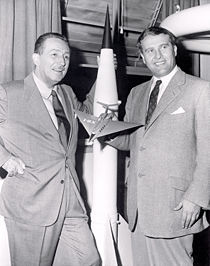
At this time von Braun also worked out preliminary concepts for a manned Mars mission which used the space station as a staging point. His initial plans, published in The Mars Project (1952), had envisaged a fleet of ten spacecraft (each with a mass of 3,720 metric tons), three of them unmanned and each carrying one 200-ton winged lander in addition to cargo, and nine crew vehicles transporting a total of 70 astronauts. Gigantic as this mission plan was, its engineering and astronautical parameters were thoroughly calculated. A later project was much more modest, using only one purely orbital cargo ship and one crewed craft. In each case, the expedition would use minimum-energy Hohmann transfer orbits for its trips to Mars and back to Earth.
Before technically formalizing his thoughts on human spaceflight to Mars, von Braun had written a science fiction novel, set in 1980, on the subject. According to his biographer, Erik Bergaust, the manuscript was rejected by no less than 18 publishers. Von Braun later published small portions of this opus in magazines, to illustrate selected aspects of his Mars project popularizations. The complete manuscript did not appear as a printed book until December 2006.
In the hope that its involvement would bring about greater public interest in the future of the space program, von Braun also began working with Walt Disney and the Disney studios as a technical director, initially for three television films about space exploration. The initial broadcast devoted to space exploration was Man in Space, which first went on air on March 9, 1955.
Concepts for orbital warfare
Von Braun developed and published his space station concept during the very "coldest" time of the Cold War, when the U.S. government for which he worked put the containment of the Soviet Union above everything else. The fact that his space station – if armed with missiles that could be easily adapted from those already available at this time – would give the United States space superiority in both orbital and orbit-to-ground warfare did not escape him. Although von Braun took care to qualify such military applications as "particularly dreadful" in his popular writings, he elaborated on them in several of his books and articles. This much less peaceful aspect of von Braun's "drive for space" has recently been reviewed by Michael J. Neufeld from the Space History Division of the National Air and Space Museum in Washington.
NASA career
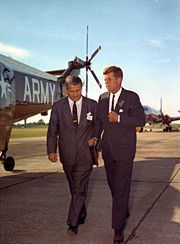
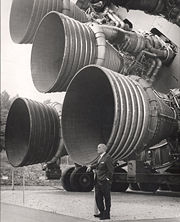
The U.S. Navy had been tasked with building a rocket to lift satellites into orbit, but the resulting Vanguard rocket launch system was unreliable. In 1957, with the launch of Sputnik 1, there was a growing perception within the United States that America lagged behind the Soviet Union in the emerging Space Race. American authorities then chose to utilize von Braun and his German team's experience with missiles to create an orbital launch vehicle.
NASA was established by law on July 29, 1958. One day later, the 50th Redstone rocket was successfully launched from Johnston Atoll in the south Pacific as part of Operation Hardtack. Two years later, NASA opened the new Marshall Space Flight Centre at Redstone Arsenal in Huntsville, Alabama, and the ABMA development team led by von Braun was transferred to NASA. In a face-to-face meeting with Herb York at the Pentagon, von Braun made it clear he would go to NASA only if development of the Saturn was allowed to continue. Presiding from July 1960 to February 1970, von Braun became the centre's first Director.
The Marshall Centre's first major program was the development of Saturn rockets to carry heavy payloads into and beyond Earth orbit. From this, the Apollo program for manned moon flights was developed. Wernher von Braun initially pushed for a flight engineering concept that called for an Earth orbit rendezvous technique (the approach he had argued for building his space station), but in 1962 he converted to the more risky lunar orbit rendezvous concept that was subsequently realized. His dream to help mankind set foot on the Moon became a reality on July 16, 1969 when a Marshall-developed Saturn V rocket launched the crew of Apollo 11 on its historic eight-day mission. Over the course of the program, Saturn V rockets enabled six teams of astronauts to reach the surface of the Moon.
During the late 1960s, von Braun played an instrumental role in the development of the U.S. Space & Rocket Centre in Huntsville. The desk from which he guided America's entry in the Space Race remains on display there.
During the local summer of 1966/67, von Braun participated in a field trip to Antarctica, organized for him and several other members of top NASA management. ( Photo of von Braun at South Pole]) The goal of the field trip was to determine whether the experience gained by US scientific and technological community during the exploration of Antarctic wastelands would be useful for the manned exploration of space. Von Braun was mainly interested in management of the scientific effort on Antarctic research stations, logistics, habitation and life support, and in using the barren Antarctic terrain like the glacial dry valleys to test the equipment that one day would be used to look for signs of life on Mars and other worlds.
In an internal memo dated January 16, 1969 von Braun had confirmed to his staff that he would stay on as a Centre Director at Huntsville to head the Apollo Applications Program. A few months later, on occasion of the first moon-landing, he publicly expressed his optimism that the Saturn V carrier system would continue to be developed, advocating manned missions to Mars in the 1980s
However, on March 1, 1970, von Braun and his family relocated to Washington, D.C., when he was assigned the post of NASA's Deputy Associate Administrator for Planning at NASA Headquarters. After a series of conflicts associated with the truncation of the Apollo program, and facing severe budget constraints, von Braun retired from NASA on May 26, 1972. Not only had it become evident by this time that his and NASA's visions for future U.S. space flight projects were incompatible; it was perhaps even more frustrating for him to see popular support for a continued presence of man in space wane dramatically once the goal to reach the moon had been accomplished.
Career after NASA
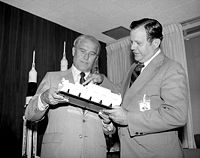
After leaving NASA, von Braun became Vice President for Engineering and Development at the aerospace company, Fairchild Industries in Germantown, Maryland on July 1, 1972.
In 1973 a routine health check uncovered kidney cancer which during the following years could not be controlled by surgery. Von Braun continued his work to the degree possible, which included accepting invitations to speak at colleges and universities as he was eager to cultivate interest in human spaceflight and rocketry, particularly with students and a new generation of engineers. On one such visit in the spring of 1974 to Allegheny College, von Braun revealed a more personal, down-to-earth side of himself as a man in his early 60s, beyond the public persona most saw, including an all-too-human allergy to feather pillows and a subtle, if not humorous disdain for some rock music of the era.
Von Braun helped establish and promote the National Space Institute, a precursor of the present-day National Space Society, in 1975, and became its first president and chairman. In 1976, he became scientific consultant to Lutz Kayser, the CEO of OTRAG, and a member of the Daimler-Benz board of directors. However, his deteriorating condition forced him to retire from Fairchild on December 31, 1976. When the 1975 National Medal of Science was awarded to him in early 1977 he was hospitalized, and unable to attend the White House ceremony. On June 16, 1977, Wernher von Braun died in Alexandria, Virginia at the age of 65. He was buried at the Ivy Hill Cemetery in Alexandria, Virginia.
Published works
- First Men to the Moon, Holt, Rinehart and Winston, New York (1958). Portions of work first appeared in This Week Magazine.
- Project Mars: A Technical Tale, Apogee Books, Toronto (2006). A previously unpublished science fiction story by Dr. von Braun. Accompanied by paintings from Chesley Bonestell and von Braun's own technical papers on the proposed project.
- The Voice of Dr. Wernher von Braun, Apogee Books, Toronto (2007). A collection of speeches delivered by von Braun over the course of his career.
Quotations
Upon surrendering with his rocket team to the Americans in 1945: "We knew that we had created a new means of warfare, and the question as to what nation, to what victorious nation we were willing to entrust this brainchild of ours was a moral decision more than anything else. We wanted to see the world spared another conflict such as Germany had just been through, and we felt that only by surrendering such a weapon to people who are guided by the Bible could such an assurance to the world be best secured."
"All of man's scientific and engineering efforts will be in vain unless they are performed and utilized within a framework of ethical standards commensurate with the magnitude of the scope of the technological revolution. The more technology advances, the more fateful will be its impact on humanity."
"If the world's ethical standards fail to rise with the advances of our technological revolution, the world will go to hell. Let us remember that in the horse-and-buggy days nobody got hurt if the coachman had a drink too many. In our times of high-powered automobiles, however, that same drink may be fatal...."
On Adolf Hitler: "I began to see the shape of the man – his brilliance, the tremendous force of personality. It gripped you somehow. But also you could see his flaw — he was wholly without scruples, a godless man who thought himself the only god, the only authority he needed."
Honours
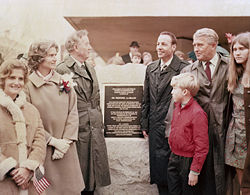
- Elected Honary Fellow of the B.I.S. in 1949
- Deutsches Bundesverdienstkreuz in 1959
- Smithsonian Langley Medal in 1967
- NASA Distinguished Service Medal in 1969
- National Medal of Science in 1975
- Werner-von-Siemens-Ring in 1975
- Civitan International World Citizenship Award
Posthumous recognition and critique
- Apollo space program director Sam Phillips was quoted as saying that he did not think that America would have reached the moon as quickly as it did without von Braun's help. Later, after discussing it with colleagues, he amended this to say that he did not believe America would have reached the moon at all.
- The von Braun crater on the moon was so named by the IAU in recognition of von Braun's contribution to space exploration and technology.
- Von Braun received a total of 12 honorary doctorates, among them (on January 8, 1963) one from the Technical University of Berlin from which he had graduated.
- Von Braun was responsible for the creation of the Research Institute at The University of Alabama in Huntsville. As a result of his vision, the university is one of the leading universities in the nation for NASA-sponsored research. The building housing the university's Research Institute was named in his honour, Von Braun Research Hall, in 2000.
- Several German cities ( Bonn, Neu-Isenburg, Mannheim, Mainz), and dozens of smaller towns, have named streets after Wernher von Braun. Remarkably, all these places are situated in Germany's Southwest and South - the American and French parts of the Allied occupation zones. There seem to be no von Braun streets in the northern parts of the former Federal Republic of Germany, which were occupied by the British. Having had London suffer from his rockets, it is quite understandable that the United Kingdom would have discouraged German attempts at honoring von Braun.
- The Von Braun Centre (built 1975) in Huntsville, Alabama is named in von Braun's honour.
- Scrutiny of von Braun's use of forced labor at the Mittelwerk intensified again in 1984 when Arthur Rudolph, one of his top affiliates from the A-4/V2 through to the Apollo projects, left the United States and was forced to renounce his citizenship in front of the alternative of being tried for war crimes.
- A science- and engineering-oriented Gymnasium in Friedberg, Bavaria was named after Wernher von Braun in 1979. In response to rising criticism, a school committee decided in 1995, after lengthy deliberations, to keep the name but "to address von Braun's ambiguity in the advanced history classes."
- An avenue in the Annadale section of Staten Island, NY was named for him in 1977.
